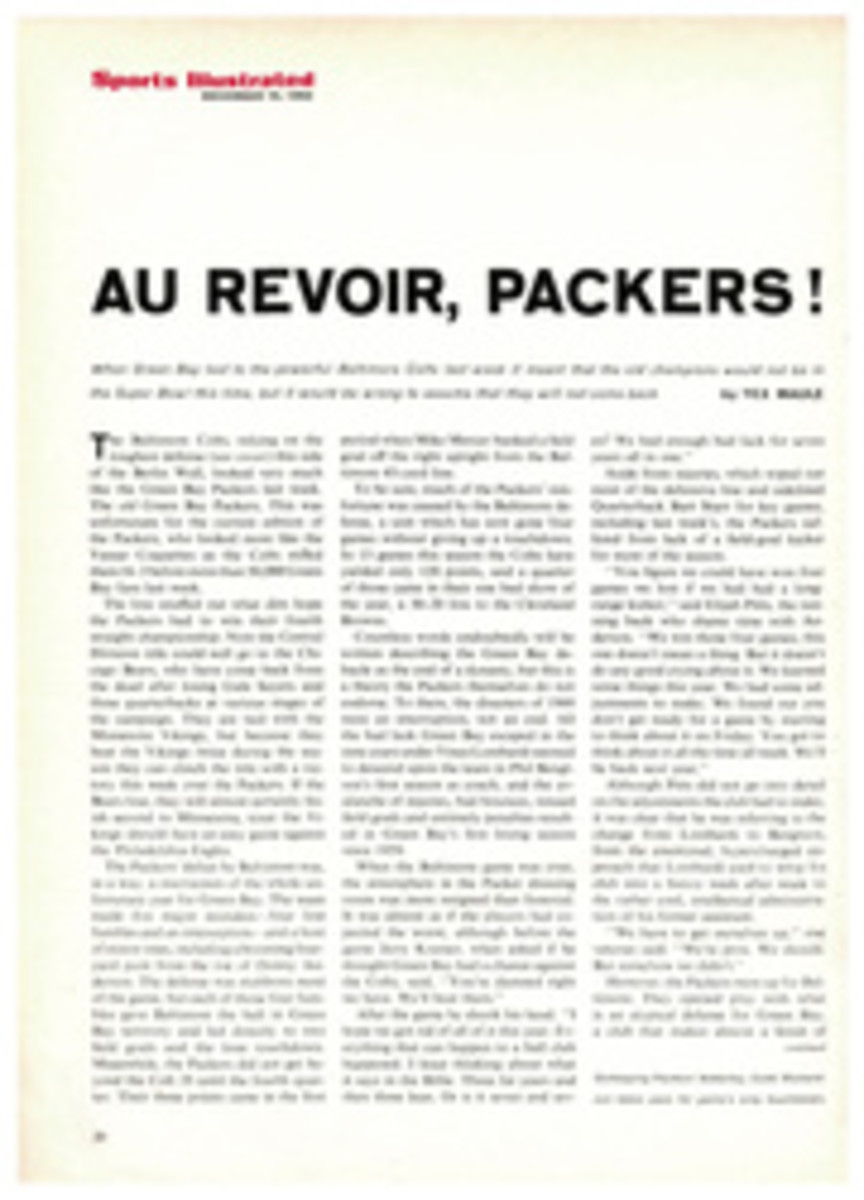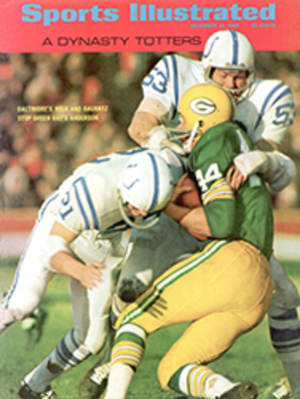
30 Acres of Romance, Hokum and Balderdash
In the 1890s the field called Montgomery Oval had been the home of a Jersey City baseball team in the old Eastern League. But by April 26, 1921 it was really nothing more than a section of swampland in the middle of Jersey City, so recently filled in with garbage that it was still cluttered with rubble and refuse, tin cans, glass and broken boards. Then, onto the derelict oval walked George Lewis (Tex) Rickard—"the magnificent rube" as a biographer would later call him—to wave his wooden walking cane and begin a magical transformation. In just over two months, re-christened Boyle's Thirty Acres in honor of a local businessman who owned a piece of it, that littered field became a battleground known to all the world as the scene of a heavyweight boxing contest touted as second only to that between David and Goliath.
The fight itself was a result of the times. A great war had ended three years earlier. The nation's heroes were its doughboys; its villains, the "slackers." And the criteria by which they were chosen, emotion. Jack Dempsey, now a respected elder statesman of the ring and a jovial Broadway host was top villain. Officially long-acquitted of draft dodging, he was yet condemned by everyone from the newly formed American Legion to the International Reform Bureau for not having "done his bit" in the armed forces.
Georges Carpentier—the Orchid Man, the First Citizen of Lens—was a natural for "hero." The idol of all women, wounded twice during the war, decorated with both the French Médaille Mllitaire and the Croix de Guerre with palm, he bore the added mantle of certain martyrdom. "I hope Carpentier wins," people were saying, "but I'm afraid Dempsey'll knock his block off."
Carpentier's mediocre record and light-heavyweight body (a frail-looking 172 pounds to Dempsey's 188) went almost unnoticed amid the waves of emotion. The fight was a glaring mismatch, yet there was that waspish Irishman George Bernard Shaw calling Carpentier a Greek god with a punch, comparing him with Sweden's 17th century child-king, Charles XII, and warning that "he must be either Carpentier or the devil for genius could not be more unmistakable."
And The New York Times cast the Frenchman as not only the representative of his country but of the "millions of soldiers who had fought in the trenches."
It was all hokum, and no one knew it better than Rickard. To keep it going, he surrounded the challenger with a cloak of unavailability. Carpentier's training camp was closed to reporters. He was working on a "secret punch." And if this wasn't enough to quell skeptics, there was always the strange case of François Descamps' hypnotic eye.
This particular story had spread in the two fights Carpentier won just before meeting Dempsey, when both his victims, Bombardier Billy Wells and Joe Beckett, claimed they were whammied by Descamps, Carpentier's manager. "I felt uneasy with that man staring at me," Wells claimed. "I felt queer all over, even before Carpentier landed his first blow," said Beckett. The story became so believable that even during the week of the fight, a Paris newspaper, Le Petit Parisien, suggested that Descamps be made to wear opaque motorcycle goggles "through which the malevolent emanations would be unable to pass."
To add to the growing pile of press clippings, ticket orders and money came flowing into Rickard's office. There was over $100,000 even before the site was announced, $650,000 with one month left and, finally, the magic $1 million five days before the meeting of two men who had suddenly become more than mere mortals.
Meanwhile, the workmen were working their own miracle on Boyle's Thirty Acres. The land had been cleared, some 60,000 cubic yards of earth dug away, and by mid-May the all-wood octagon started rising toward its place in the sky. Capacity was altered from a planned 50,000 to a new 70,000 and again to the final 91,613. As plans expanded, construction costs rose from the intended $125,000 to twice that figure, and the whole eastern seaboard had to be combed for the 2.25 million board feet of lumber needed to complete the job. Why were plans changed so often? "It was just that ticket sales were so good, we had to keep adding on and on," said one of the workmen. As a result the final numbers were not stenciled onto the seats until the night before the fight.
By that time people all over the world were waiting for what was now being called the Battle of the Century. The Jersey City and Newark baseball teams called off a doubleheader because of the fight. Paris waited to be informed by lights on a plane flying overhead—red for Carpentier, white for Dempsey. Other planes waited near Jersey City itself to fly pictures of the fight to Chicago for the next morning's Tribune and to ships already at sea for final transport to Europe. And everywhere people were praying that right would triumph over might and that Carpentier the Hero would beat Dempsey the Slacker, MAY A REAL FIGHTER AND A REAL MAN WIN, the Tennessee branch of the American Legion wired the Frenchman, "and carry the belt across the seas until this country can produce a 100% American able to regain it."
At Boyle's, 2,900 police, firemen, plainclothesmen and private ushers waited to handle the crush, setting up blockades four blocks away from the stadium, letting only properly accredited people into the menagerie. The final count was to be 80,183, representing every level of life.
Most came by subway and buses. The famous names, however, arrived in limousines and private railway cars and yachts and chartered tugboats. William H. Vanderbilt. John D. Rockefeller Jr. Henry Ford. Harry Payne Whitney. Vincent Astor. George M. Cohan. Jake Ruppert. And Al Jolson, who had closed his show in Butte, Mont, so he could attend. The celebrities sat down front in the $50 ringside seats (folding chairs brought over from Madison Square Garden). Behind them, on benches of spruce, were the common people, the peasants who had paid $40, $30, $25, $20, $15, $10 and $5.50.
As Carpentier entered the arena to the accompaniment of wild cheers, there occurred something that might well have turned boxing's brightest day into tragedy. Up in section H, back in the $5.50 seats, the final additions, the stadium started to sway.
"There was just a movement," an engineer who helped build the stands says today. "Don't make too big of a thing out of it. There was a movement, a decided sway. But there really was never any danger of the stadium collapsing. None."
The people in the stands at the time were far from convinced of this. "Everybody stay down," one man yelled. Then he turned to a policeman. "If you police can't make them sit down, club them down."
Unaware of what was happening behind them, those in front watched Dempsey cutting Carpentier in the first round, getting stunned in the second, then mercilessly punishing the challenger in the third, before knocking him out in the fourth. Many were silent. Some cried.
The next day The New York Times ran an eight-column banner on its front page and filled six of its eight news columns with stories of the fight. (Only the day's news of President Harding, an attempted suicide and the marriage of the Duchess of Marlborough were permitted to share the page.) For the next 12 pages there were, again, nothing but fight stories and pictures. As if in apology, the staid old journal editorialized that same day, "The world may now gain its equipoise."
Three days later a group of engineers checked the stadium and found it safe. It stood for six more years, then Rickard had it torn down. Today, Boyle's Thirty Acres are lost in the middle of a housing project, the only echo of their sporting past lying in the shouts of the boys of Ferris High School of Jersey City as they shag grounders on the project's baseball diamond.

